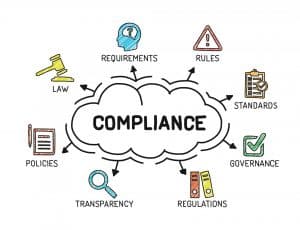Compliance Training Definition
Compliance training helps employees know the laws and regulations of the industry, and is an essential layer of safety for companies and employees.
The formal, educational program will have employees receive learning material about policies and procedures.
What’s the benefit?
Training employees on compliance topics helps avoid disruptive violations at the workplace. Usually a mandatory requirement, compliance training online has recently gained popularity.
In a 2016 study of risk management employers, 68% admitted that their compliance department was not sufficiently resourced. Fortunately, the tides are changing.

Why compliance training is so important?
Compliance training is essential for every organization to ensure a safe and secure work environment. Companies owe it to their employees as well as the general public. Without compliance training, companies run the risk of getting involved in messy legal troubles and spoiling their image in the public eye.
New data from DDI’s Frontline Leader Project suggests that over 57% of employees leave their job after being harassed by a manager. The onus is also on companies to protect the data and privacy of their consumers and employees. Another 2020 survey by Elucidat found that 44% of financial services employees feel that their mandatory compliance training did not equip them with the required knowledge.
As an employer, you need to create a work atmosphere that is free of harassment. Compliance training solutions help you do just that by helping you get:
- Safer workplace
- Higher attendance
- Organization insurance
- Increased productivity
- A lesser risk for any legal action
- Secures business reputation
New employees want reassurance that their employer respects them. Compliance training is an indication that you are willing to go the extra mile when it comes to protecting their dignity.
You can use different compliance training tools to make your employees knowledgeable and aware of every aspect of their job. Trained employees will execute their duties confidently, and the company will also get legal accountability.
Compliance training fosters a healthy work environment where all the employees feel safe and protected.
How to make compliance training engaging?
Compliance training does not leave a lot of room for creativity because the learning material tends to be dry and formal.
The technical jargon puts off employees from actually engaging in the training. First, the language can be difficult to comprehend. Second, it is a lot of information to retain. In the same Elucidat survey we talked about before, 15% of financial services employees revealed that they clicked through the lesson without reading or listening, and 34% admitted that they just skimmed through it.
The primary objective of compliance training is to make employees understand why the content is relevant and have them agree to abide by the regulations. Compliance courses, hence, should be able to hold their attention for a long time. The following tips will help you make engaging compliance training content:
1. Focus on simplicity
You can use simple and lucid language to explain the technical aspects. Break down the tough ideas and use multiple examples and scenarios to get the point across.

2. Use case studies
One of the best ways to explain technical concepts to a layperson is to use plenty of real-life examples and case studies. Cover all the compliance training topics and then provide scenarios in which they will be applicable.
Employees will find it easier to understand the relevance of the content to their work lives. Compliance training examples will allow employees to explore the consequences of their actions through simulation.
3. Microlearning
Bite-sized lessons are easier to study and remember. Employees will find the content more engaging if they can take their time going through it. For example, compliance videos for employees will not only allow them to squeeze in a quick lesson between work sessions, but it will also be more comprehensible. Microlearning increases information retention by 20% as compared to a lengthy training process.
Examples of compliance training
There are different types of compliance training for different industries. For example, employees who work in the IT sector will receive compliance training in online security and data privacy. On the other hand, employees who work in a warehouse need to be trained in basic workplace safety.
Healthcare workers receive compliance training in using medical equipment and work hazards. Popular compliance training subjects include:
- Pharmaceutical
- Insurance
- Workplace safety training
- Workplace harassment training
- HR compliance training
- Anti-harassment training
- Information security training
- Trade compliance training
- Data protection & privacy training
- Bank compliance training
- Diversity training
- Regulatory
- Environmental
However, all industries can use common compliance training tools like quizzes, videos and real-life simulations.

Healthcare compliance training
Medical workers need to stay updated to deliver the best care. Healthcare compliance training can be expensive, but a tool like Bites can help cut down the cost significantly.
Compliance training in the healthcare industry includes:
- Providing patients with vital information at every stage
- Training the staff in the latest technologies
- Informing all the employees about the rules they have to follow
- Demonstrating new medical devices or equipment
Hospitality compliance training
The hospitality industry caters to the general public. Hotels, restaurants and bars need a good reputation to appeal to more customers. Hospitality compliance training is crucial for employees so that customers get the best treatment possible.
On the other hand, compliance training for employees informs them about the safety measures protecting them, including hygiene, bar staff training and first aid training.
Different types of compliance
Certain compliance training topics get more attention than others. They are included in most compliance training programs, justifiably.
· Anti-harassment
Anti-harassment policies outline the measures to be taken by employees in case of bullying or any kind of harassment.
This also includes strategies that can be used by employees to fight back. 36% of organizations still do not offer sexual harassment compliance training.
· Data Protection
Compliance training lists the measures to be taken by employees to secure their data and the company’s data. The employees are also expected to know the laws and regulations related to data loss.
· Diversity training
Diversity training is a priority, and no company should forego it. Diversity in a company should not just be a token of political correctness. Instead, it should be seen as a cornerstone of global success.
Diversity training teaches employees to work together and embrace multiple perspectives. A diverse workplace allows for more opportunities because the employees are more open to different approaches.
· Cybersecurity
Cybersecurity laws and regulations are included in all cybersecurity compliance training programs. Employees are also taught methods by which they can handle confidential information. They also learn about the tools and systems in place to protect customer data.

· Organization ethics
Every company has a code of ethics. Compliance training includes rules and conditions for disciplinary action. It details any grey area and also offers strategies to deal with conflicts of interest.
· Workplace safety
Basic workplace safety standards are important to establish right at the beginning so that employees know what to do in case of emergencies.
Compliance training
Compliance training, online or offline, requires effort and patience. There are a number of compliance training tools you can use to train your employees effectively.
-
Compliance videos:
Visual content tends to be engaging and attractive which is why you should begin using compliance training videos as your primary teaching tool. Making videos does not have to be a time-consuming process.
In fact, Bites makes the process super simple for you. All you have to do is record a short video covering one small topic and then edit it to create a bite. Once you create a number of bites, you can add them to a playlist and share it with all your employees. Microlearning through videos is an effective tool to help your employees retain the information they learn.
-
Interactive learning:
Passive learning does not have the same impact as interactive learning. Employees need to pose their questions and clear their doubts during the training itself. You can even create interactive lessons that allow the employees to register what they are learning faster.
-
Simulation:
Experience happens to the most effective teacher. Simulating real-life scenarios allow employees to understand the content and not just read through it. The storytelling aspect definitely enhances the experience, and the employees can relate what they learn to their real life.
-
Gamification:
You can increase the engagement of your employees tremendously by introducing gaming elements into your lessons. The idea is to add a competitive edge to the lessons to motivate the employees.
Throwing in a compliance training quiz here and there will help the employees be accountable. You can make fun quizzes that are challenging and fulfilling. The objective is to make the employees feel a sense of achievement every time they meet their goal.
Best Practices for Compliance Training
Compliance training for small businesses and big businesses can share some common practices.
· Adjust the training based on your audience
You cannot have one set of training materials. Instead, you have to develop multiple sets of learning content for different levels and types of employees. Virtual knowledge databases are easier to manage.

· Encourage mobile learning
Make sure that your training materials can be accessed via multiple devices. Each department can then choose the training method that suits them best.
· Situations over documents
Handing over a bunch of legal compliance documents to your employees will often have the opposite effect of what you intended. You need to simplify the content for training sessions so that the employees can connect the information to relatable everyday situations.
· Storytime
If you are having trouble creating engaging content, immersive storytelling will be your best friend. Narrate real-life situations as a story so that your employees do not feel bored. You can even add some images to make it more interesting. Pick a relatable character whose experiences will resonate with the team.
· Blended learning
Online training is the way of the future but you do not have to use it exclusively. You can combine offline training sessions with virtual ones so that you have the convenience of accessibility without losing out on the emotional connection.
· Offer practical solutions
While it is great to tell your employees that they should not do certain things, look to back it up with solutions of how they can avoid them.
· Be transparent
Compliance training is about honesty and you cannot sugarcoat the lessons. Be completely open with your employees about the consequences of them not abiding by the training.
Summary
Compliance training for employees has never been more important. If you want to protect your employees and maintain the company’s reputation, in the long run, you have to invest in compliance training solutions that are easily understandable. Employees who understand the rules and regulations they are supposed to follow are less likely to put the company in danger.
With Bites, workplace compliance training is now simple and effective. You can create the learning material in the form of short videos or bites and compile them into a compliance training playlist. You can skip the dry technical language and make your delivery animated.
This happens to be one of the most cost-effective compliance training solutions. There is no need to worry about on-site arrangements, and you can easily train your remote employees.
Bites allows you to present a compliance training quiz from time to time to test the employees’ knowledge. The option to embed a checklist will help your employees to follow the steps to become compliant. Make sure to use the analytics feature to track their




